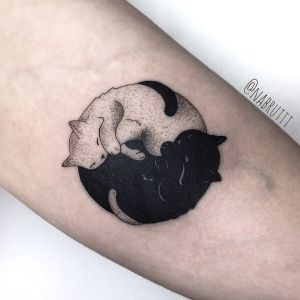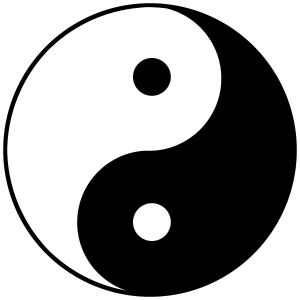Yin Yang Tattoos
So much about tattooing is about symbolism and deeper meaning behind motives and designs (although nothing wrong with body art just being aesthetic for the sake of it). Certain symbols are universally recognisable across much of the globe, despite having originated in one particular culture. And they often keep recurring as motives for tattoos, as new generations all over the world connect to their inherent purpose and meaning.

The quest for balance in the cosmos
One such symbol is the yin-yang. Instantly identifiable with its opposing black and white balanced sides of a circle, the symbol originated in China, and can be traced at least to the third century BC. In China, it is referred to as the Tai-Ji – the great polarity.
The two sides, yin and yang, can be considered as complementary, rather than opposing, forces. These interact within a dynamic system where the universe creates itself out of a primary chaos of material energy – Wuji. They organise qi, life force, into material things like our bodies, phones, trees, building materials that make up our houses, protons, neutrons – even chocolate or beer.
There are variants of the symbol, and many of them make for great tattooing motives. Meanwhile, the most commonly used is a circle composed of two interlocking teardrop shapes, one black and one white. Each one has a dot of the opposing colour in the middle, to demonstrate how there can be no yang without yin, and vice versa.
From oracle bones 3000 years ago to skin today
The concept has existed for thousands of years, with the earliest known reference occurring on oracle bones that described different aspects of nature. Meanwhile, the ideas spread more widely, unfolding into and attaching themselves to philosophical theories (or the other way around) from 1000 BC onwards. This was also when the symbol started becoming an important part of Taoism, a spiritual tradition emphasising achieving harmony with nature.
Two sides are said to represent different categories of being, although they cannot exist without each other, and both contain something of the other. Yin (black) is normally considered to be ‘feminine’, receptive, cool, moon, contemplation, stillness, quiet, night time and contraction. Yang (white) on the other hand is referred to as the ‘masculine’ energy, characterised by movement, action, heat, sun, open, day time and expansive. They flow dynamically in and out of dominating one another, replacing each other in a constant quest for harmony.
 The outer circle of the symbol represents the universe in its entirety (whatever that is has to remain a discussion for another time), and everything that exists in it. It encompasses all the dualities represented by the yin and the yang.
The outer circle of the symbol represents the universe in its entirety (whatever that is has to remain a discussion for another time), and everything that exists in it. It encompasses all the dualities represented by the yin and the yang.
As a society, we tend towards an excess of yang energy. Everything has to move fast and be done now. There is less and less time to rest, contemplate, and turn inwards. This shows up in an increasing number of burnouts and mental health issues across the globe, particularly in the western world. In a world that is showing no signs of honouring our humanity rather than our productivity, it is no wonder that people are longing for the kind of balance that the yin yang symbol represents. The next time you see it adorning someone’s skin, take it as a sign it is time to invite a little bit more rest in order to restore balance. Or perhaps better yet, get your very own and keep the reminder close by at all times.
